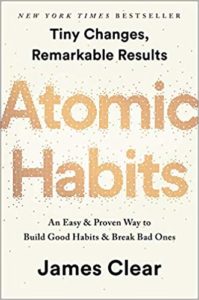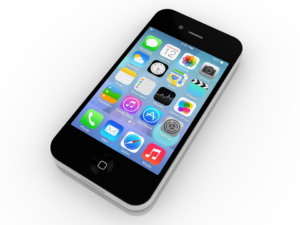Last week, we began discussing James Clear’s excellent book, Atomic Habits: An Easy and Proven Way to Build Good Habits and Break Bad Ones. (#ad) We talked about three starting points for habit formation: 1) improving by 1% each day, 2) relying on systems rather than focusing on goals, and 3) focusing on identity rather than outcomes.
These were just the introductory concepts. The main idea of the book had to do with the 4-step process to building a habit: cue, craving, response, and reward. This is very similar to the cue, routine, reward, and craving pattern found in Charles Duhigg’s The Power of Habit. (#ad) [1]
Habit Formation
For now, we will consider only Clear’s model for habit formation. This begins with a cue.
Cue
All habits begin with cues. Cues, however, are not always obvious. We respond to cues without even realizing it. A few examples will illustrate this point. Have you ever passed a McDonalds and turned in to grab something to eat before you consciously thought that you were hungry and that you should stop? Or, have you picked up your phone to check a text because it vibrated?[2] (I found I spent an enormous amount of time responding automatically to this interruption, which is why I turned all notifications off).
These are cues. They direct our behavior, often without our notice. This last clause—without our notice is the most important. To intentionally form a habit, make the cue visible. Then, you have a fighting chance.
If you are intentional about what cues prompt your behavior, you can shape your environment to aid you in accomplishing your desired behavior. Want to take your vitamins every day? Leave the bottle on your desk so you will see it when you sit down to work. Or, place the bottle on top of your wallet when you go to sleep so you cue yourself to take them before you leave the house.
Craving
Cues only go so far in themselves. In many cases, we fail because cues are not sufficiently attractive. For example, the cue of a workout machine or stationary bike does little to motivate us to workout unless we feel a craving for the cue.
However, if you can develop a craving for exercise, the cue that leads to the craving will directly lead to a response. This pattern works. I know runners who crave the runner’s high (what I call “pain”). I know very productive businessman who crave the satisfaction of checking off massive lists of activities that they have to get done (what I call “work”). I know a small entrepreneur who owns a landscaping company. He wasn’t happy until he was covered in dirt (what I call “filth”). The trick, then, is to crave what you should.
In Clear’s terms, you have to make the cue attractive.
Do you need to spend more time conducting sales calls? First, spend more time with great salesman. They enjoy talking about selling. In time, you’ll start emulating their thoughts and behaviors. In sum, the cue must point you toward something you enjoy. If it does, you will easily move from cue to craving to response.
Response
When a person does something, and he enjoys it, that action is often repeated. A habit cannot form until some action takes place and it is repeated. Repeated action is the very definition of a habit. There are a few things you can do to increase the odds of repeating good behaviors.
First, reduce the friction. This means that you make it easy on yourself to complete the tasks that you are trying to develop. Perhaps you want to be more efficient at work. Efficiency thrives in an environment of order and simplicity. When you need to lay your hand on a particular form, you need to know how to find it without digging through a pile. Filing in a pile is efficient in the short run but inefficient in the long run. When you file effectively, you reduce later friction. As clear wrote,
When we remove the points of friction that sap our time and energy, we can achieve more with less effort. (This is one reason tidying up can feel so good: we are simultaneously moving forward and lightening the cognitive load our environment places on us.)[3]
Next, determine ahead of time what you will do in a given situation. If you know, for example, that you have a tendency to waste time at work surfing social media or discussing the big game, decide now to disengage from the Internet for select periods of time, or work on an important project for a particular set of time while everyone else discusses the game. By choosing to disconnect from the Internet or choosing to be at your desk when others are discussing the game you made small choices that have vastly increase the odds that you accomplish your objectives.
Dave Ramsey uses this concept when he advises people who are struggling with debt to take steps that prevent them from being swept up in the moment. He advises them to remove their credit card information from Amazon or place their credit cards in a jar of water that they place in the freezer. This gives their impulses time to thaw as they wait for the block of ice to do the same. He will even encourage his readers to cut up their credit cards altogether.[4] It turns out that it’s easy not to spend when you have no means to do it.
Finally, Clear argues that you should automate many of the actions that you want to take. You can program internet blockers to turn your internet off at 10 PM so you are not tempted to surf the web when you should sleep. Similarly, if you are struggling with temptations at the grocery store, Wal-Mart will allow you to order online and a helpful attendant will carry your groceries out to your car. No need to even enter the store. “Technology can transform actions that were once hard, annoying, and complicated into behaviors that are easy, painless, and simple. It is the most reliable and effective way to guarantee the right behavior.”[5]
Reward
Actions make behaviors happen now. But how do we ensure that they happen again? Clear wrote,
The first three laws of behavior change—make it obvious, make it attractive, and make it easy—increase the odds that a behavior will be performed this time. The fourth law of behavior change—make it satisfying—increases the odds that a behavior will be repeated next time.[6]
So what can you do to make good habits more likely to be satisfying? Track it. Then reward yourself for the behavior. For example, if you are trying to save money, every time you legitimately skip an unnecessary purchase, log that and track how much you saved. This action creates a reward loop that makes it more likely that you will continue the good behavior.
My favorite story in this regard was about a young stockbroker named Trent Dyrsmid.
Dyrsmid began each morning with two jars on his desk. One was filled with 120 paper clips. The other was empty. As soon as he settled in each day, he would make a sales call. Immediately after, he would move one paper clip from the full jar to the empty jar and the process would begin again. ‘Every morning I would start with 120 paper clips in one jar and I would keep dialing the phone until I had moved them all to the second jar,’ he told me. Within eighteen months, Dyrsmid was bringing in $5 million to the firm. By age twenty-four, he was making $75,000 per year—the equivalent of $125,000 today. Not long after, he landed a six-figure job with another company.[7]
You can apply this method and reward yourself in any number of ways so long as the reward encourages you to keep going and is not at cross-purposes with your goals (e.g., eating ice cream as a reward for losing weight).
What About You?
So now you have the 4-step plan for building good habits. What new habit will you develop?
References
[1] Duhigg, C. (2014). The power of habit: Why we do what we do in life and business. New York: Random House.
[2] Though I independently arrived at the cell phone example, it is so close to Clear’s example that it deserves citation: Clear, J. (2018). Atomic habits: An easy and proven way to build good habits and break bad ones. New York: Penguin Publishing Group. (p. 62).
[3] Clear, J. (2018). Atomic habits: An easy and proven way to build good habits and break bad ones. New York: Penguin Publishing Group. (p. 154).
[4] Ramsey, D. (2003). Financial Peace revisited. New York: Viking. (p. 78)
[5] Clear, J. (2018). Atomic habits: An easy and proven way to build good habits and break bad ones. New York: Penguin Publishing Group. (p. 154).
[6] Clear, J. (2018). Atomic habits: An easy and proven way to build good habits and break bad ones. New York: Penguin Publishing Group. (p. 186)
[7] Clear, J. (2018). Atomic habits: An easy and proven way to build good habits and break bad ones. New York: Penguin Publishing Group. (p. 195)
___________

Dr. Darin Gerdes is a tenured Professor of Management in the College of Business at Charleston Southern University.
All ideas expressed on www.daringerdes.com are his own.
This post was originally created for Great Business Networking (GBN), a networking organization for business professionals where Dr. Gerdes is the Director of Education.
FTC Disclosure: When I refer to a book, I often add a link to Amazon (#ad) so you can purchase it easily. I may earn a few cents if you buy it, but I never recommend any books unless they are worth reading.
___________


